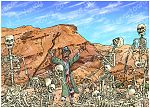Bible Cartoon: Ezekiel 37 - Valley of bones - Scene 01 - Dry bones
Click on Add to cart button below shopping cart.
Purchased Bible Cartoons do not have watermarks. Links to Cartoons provided on email once purchase is completed.Bible Book: Ezekiel
Bible Book Code: 2603700101
Scene no: 1 of 4
Bible Reference & Cartoon Description
Ezekiel 37:1-2 (NLT)
1 The Lord took hold of me, and I was carried away by the Spirit of the Lord to a valley filled with bones. 2 He led me [Ezekiel] all around among the bones that covered the valley floor. They were scattered everywhere across the ground and were completely dried out.
DRAWING NOTES:
TIME OF DAY:
None specified in the Bible verse above. I have set the scene in the mid afternoon.
LIGHTING NOTES:
Sunlight from above & right illuminates this scene, casting shadows to the left.
CHARACTERS PRESENT:
The prophet Ezekiel.
RESEARCH/ADDITIONAL NOTES:
This scene shows the prophet Ezekiel “carried away by the Spirit of the Lord to a valley filled with bones.”
Verse 1 tells us that this picture is actually a vision that the prophet Ezekiel had. As such I could have drawn a dream-like or fantastic scene, but I decided to make it realistic. I used a photograph from the internet of the Makhtesh Ramon, a long & thin geological “crater” found in the Negev desert of southern Israel. This valley is wedge-shaped, with its point (at mount Ramon) in the south west. The crater is about 25 miles long (40 km), ranging from 1 to about 8 miles wide (1.6 – 12.8km) & has a maximum depth of 1,640 ft (500 metres).
A makhtesh seems to be a unique feature to Israel. It is a steep walled valley of resistant rock which is usually drained by a single wadi (seasonal river).
Here’s the scene without the figure, bones or foxes.

Background of Ezekiel 37 – Valley of bones – Scene 01 – Dry bones
Click on the colour bar below to view/buy this Background:
Background of Ezekiel 37 – Valley of bones – Scene 01 – Dry bones
I researched pictures of human skeletons on the internet to help me draw the bones strewn all over the valley floor accurately.
Vulpes cana (Blandford’s fox)
In the right lower foreground you can see a pair of Vulpes cana (aka Blandford’s fox, Afghan fox, royal fox, king fox, corsac, black fox, dog fox, hoary fox, steppe fox, cliff fox or Balochistan fox). Blanford’s fox (Vulpes cana) is a small fox native to the Middle East and Central Asia, named after the English naturalist William Thomas Blanford, who described it in 1877. Blanford’s fox has large, wide ears and a long, bushy tail nearly equal to the length of its body. Interestingly, the body size often varies geographically. In the Afghan-Iranian region, the collected specimens had head-body lengths of 15.2 to 31.5 in (38.5 to 80 cm) and tail lengths of 13 to 16 in (33 to 41 cm), while specimens in Oman had a total length of 28.9 to 29.9 in (73.5 to 76 cm) and a tail length of 14 to 14 in (35 to 36 cm). Weights of those specimens averaged 1.9 pounds (873 grammes).
“The body is brownish-grey, fading to light yellow on the belly. The winter coat is soft and woolly, with a dense black undercoat and white fur speckles in the dorsal area; together with a somewhat thicker layer of fat, it serves as thermal insulation in cold and dry winter. The summer coat is less thick, the fur is paler, and the white hair is less noticeable. A characteristic mid-dorsal black band extends caudally from the nape of the spine, becoming a mid-dorsal crest along the length of the tail. The tail is the same colour as the body. A black spot is found at the base of the spine. The tip of the tail is normally black, but it is white in some individuals. The dark mid-dorsal line, which is a distinctive characteristic of the Israeli specimens, is less noticeable in Oman specimens, although the black tail markings are similarly developed.
Like other arid land foxes, Blanford’s fox characteristically large ear is an adaptation to enhance heat dissipation.16 However, unlike other desert foxes, it does not have pads covered with hair, and it has cat-like, curved, sharp claws described by some authors as semiretractile.
This fox has an ability to climb rocks and make jumps described as “astonishing”, jumping to ledges 9.8 ft (3 metres) above them with ease, and as part of their regular movements and climbing vertical, crumbling cliffs by a series of jumps up vertical sections. The foxes use their sharp, curved claws and naked footpads for traction on narrow ledges and their long, bushy tails as a counterbalance.”
[Source: https://en.wikipedia.org/wiki/Blanford%27s_fox]
Bible Doctrine Notes
37:1-14 GOD, Power (1.14J)
God has sovereign power over a dead nation. No realm, even death, is beyond His power and control. Despite what human beings might think, say or judge to the contrary, God can save His people no matter what. All of God’s axtions seek to introduce Himself to all people as Lord and Saviour.
37:1-14 HUMANITY, Life (2.43A)
This prophetic story occurred as the nation Israel was “dead”, in exile. God used the graphic symbol of a valley of dry bones to illustrate just how dead the Israelites really were. And yet, as the story unfolds, God shows that once dry, lifeless bones can live. In verse 14 God promised the prophet Ezekiel that He would make the nation of Israel live again. Jesus has shown us that dead believers will rise to eternal life again after physical death.





